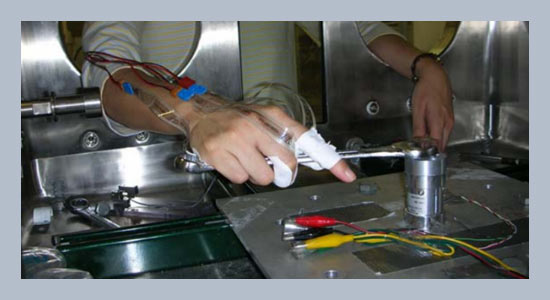REFERENCES
- [1] Eastman Kodak Company 1983. Ergonomic Design for People at Work Volume I: Workplace, Equipment, and Environmental Design and Information Transfer. Eastman Kodak Company, Van Nostrand Reinhold, New York.
- [2] Tichauer, E. R. and Gage, H. 1977. Ergonomic principals basic to hand tool design. American Industrial Hygiene Association Journal, 38: 622-634.
- [3] Barbe, M. D. and Barr, A.E. 2006. Inflammation and the pathophysiology of work-related musculoskeletal disorders. Brain, Behavior, and Immunity, 20: 423-429.
- [4] Barr, A.E., Barbe, M.F., and Clark, B.D. 2004. Work-related musculoskeletal disorders of the hand and wrist: epidemiology, pathophysiology, and sensorimotor changes. Journal of Orthopaedic and Sports Physical Therapy, 34, 10: 610- 627.
- [5] Hallbeck, M. S. 1995. Flexion and extension forces generated by wrist-dedicated muscles over the range of motion. Applied Ergonomics, 25: 379-385.
- [6] Kong, Y., Jang, H., and Freivalds, Andris 2006. Wrist and tendon dynamics as contributory risk factors in work-related musculoskeletal disorders. Human Factors and Ergonomics in Manufacturing, 16, 1: 83–105.
- [7] An, K. N., Chao, E. Y., Cooney, W. P., and Linschied, R. L. 1985. Forces in the nominal an1d abnormal hand. Journal of Orthopaedic Research, 3: 202–211.
- [8] Cooney, W. P. III and Chao, E. Y. 1977. Biomechanical analysis of static forces in the thumb during hand function. Journal of Bone and Joint Surgery American, 59: 27-36.
- [9] Smutz, W., Kongsayreepong, A., Hughes, R., Niebur, G., Cooney, W., and An, K. N. 1998. Mechanical advantage of the thumb muscles. Journal of Biomechanics, 31: 565–570.
- [10] Valero-Cuevas, F., Johanson, M. E., and Towles, J. D. 2003. Towards a realistic biomechanical model of the thumb: the choice of kinematic description may be more critical than the solution method or the variability/uncertainty of musculoskeletal parameters. Journal of Biomechanics, 36: 1019-1030.
- [11] Santos, V. J. and Valero-Cuevas, F. J. 2006. Reported anatomical variability naturally leads to multimodal distribution of Denavit–Hartnenberg parameters for the human thumb. IEEE Transactions on Biomedical Engineering, 53: 155-163.
- [12] An, K. N., Ueba, Y., Chao, E. Y., Cooney, W. P., and Linscheid, R. L. 1983. Tendon excursion and moment arm of index finger muscles. Journal of Biomechanics, 16: 419-425.
- [13] Brook, N., Mizrahi, J., Shoham, M., and Dayan, J. A. 1995. Biomechanical model of index finger dynamics. Medical Engineering and Physics, 17, 1: 54-63.
- [14] Sancho-Bru, J. L., Perez-Gonzalez, A., Vergara-Monedero, M., and Giurintano, D.J. 2001. A 3-D dynamic model of human finger for studying free movements. Journal of Biomechanics, 34: 1491– 1500.
- [15] Lee, S.W., Chen, H., Towles, J. D., and Kamper, D. G. 2008. Estimation of the effective static moment arms of the tendons in the index finger extensor mechanism. Journal of Biomechanics, Volume 41, 7: 1567-1573.
- [16] Chao, E. Y., Opgrande, J. D. and Axmear F. E. 1976. Three-dimensional force analysis of finger joints in selected isometric hand functions. Journal of Biomechanics, 9: 387-396.
- [17] An, K. N., Chao E. Y., Cooney, W. P. and Linscheid, R. L. 1979. Normative model of human hand for biomechanical analysis. Journal of Biomechanics, 12: 775-88.
- [18] Chao E. Y., An, K. N., Cooney, W. P. III, and Linscheid, R.L. 1989. Normative model of human hand, Biomechanics of the hand. World Scientific Publishing Company, 5-30.
- [19] Vigouroux, L., Domalain, M., and Berton, E. 2009. Comparison of tendon tensions estimated from two biomechanical models of the thumb. Journal of Biomechanics, 42: 1772–1777.
- [20] Sung, P. C. 2006. “Glovebox gloves: ergonomics guidelines for the prevention of musculoskeletal disorders”. Doctoral Dissertation, University of California at Los Angeles, Los Angeles, U.S.A.
- [21] Fransson-Hall, C. and Kilbom, A. 1993. Sensitivity of the hand to surface pressure. Applied Ergonomics, 24: 181-189.
- [22] Liu, V. W. C., Sung, P. C., Arias, L., Hollander, J., and MacDonald, J. 2000. Use of glovebox gloves and its ergonomic impacts. American Industrial Hygiene Conference and Exposition Abstract, May 20-25, Orlando, Florida, USA: 10.
- [23] Mathiowetz, V., Kashman, N., Volland, G., Weber, K., and Dowe, M. 1985. Grip and pinch strength: normative data for adults. Archival of Physical Medicine and Rehabilitation, 66: 69-74.
- [24] Bright, D. S. and Urbaniak, J. B. 1976. Direct measurements of flexor tendon tension during active and passive digit motion and its application to flexor tendon surgery. Transactions of 22nd Annual Meeting, Orthopaedic Research Society, p. 240.
- [25] Langenderfera, J., LaScalzaa, S., Mellb, A., Carpenter, J.E., Kuhn, J.E., and Hughes, R.E. 2005. An EMG-driven model of the upper extremity and estimation of long head biceps force. Computers in Biology and Medicine, 35: 25–39.
- [26] Dennerlein, J. T. 2005. Finger flexor tendon forces are a complex function of finger joint motions and fingertip forces. Journal of Hand Therapy, 18, 2: 120-127.
- [27] Veeger, D. H. E. J. 2011. “What if”: The use of biomechanical models for understanding and treating upper extremity musculoskeletal disorders. Manual Therapy, 16: 48-50.






